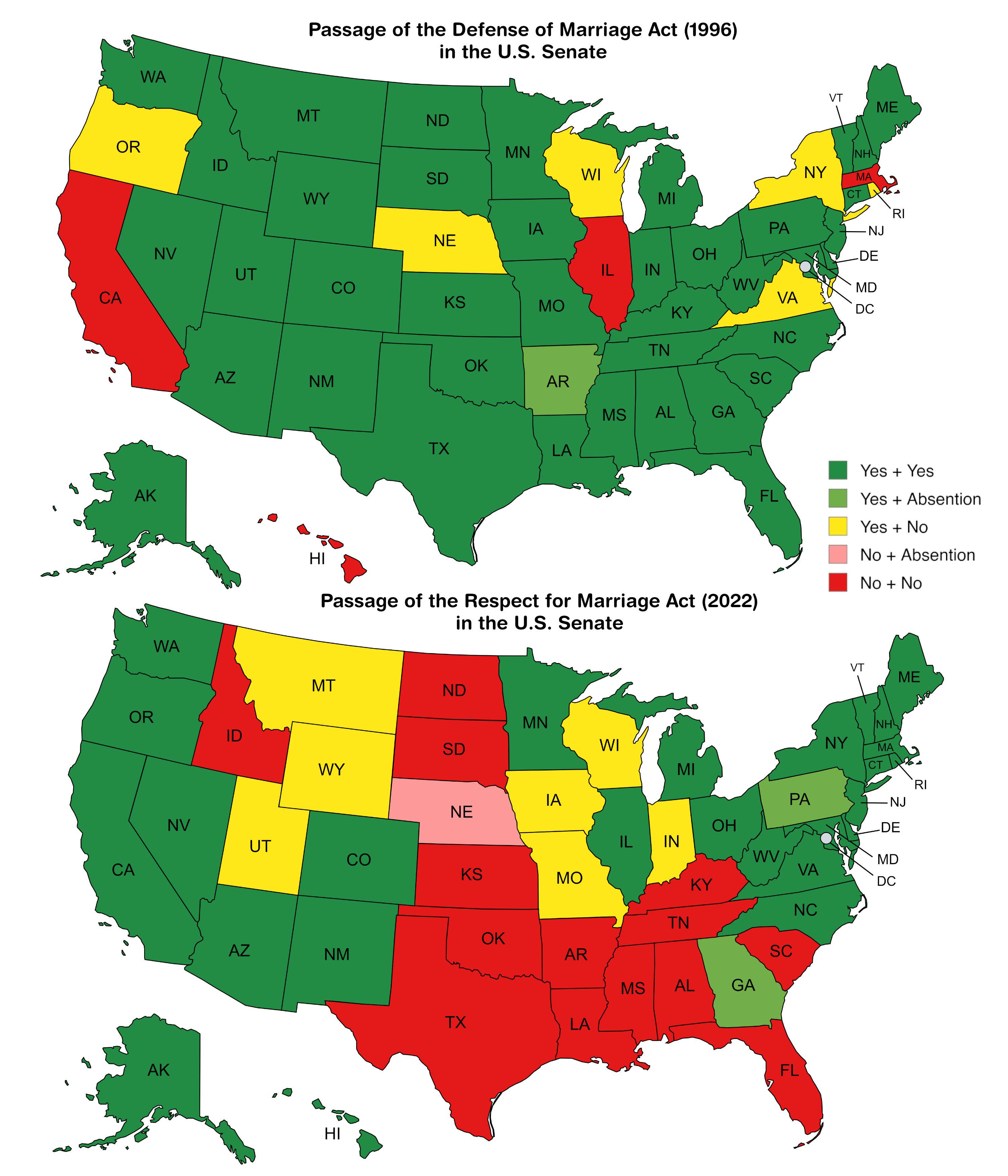Map of Defense of Marriage Act vs. Respect for Marriage Act in Senate


David Chen
Data Visualization Specialist
David Chen is an expert in transforming complex geographic datasets into compelling visual narratives. He combines his background in computer science ...
Geographic Analysis
What This Map Shows
This map illustrates the passage of two significant pieces of legislation in the U.S. Senate: the Defense of Marriage Act (DOMA) of 1996 and the Respect for Marriage Act (RMA) of 2022. It visually represents how senators voted on these pivotal laws, showcasing the political landscape surrounding marriage equality in the United States over a span of more than two decades. Each state is color-coded based on the voting patterns of its senators, providing a clear snapshot of how attitudes towards same-sex marriage have evolved over time.
Deep Dive into Marriage Legislation in the U.S.
The Defense of Marriage Act was enacted in 1996 during a time when the concept of same-sex marriage was largely unrecognized and contentious. DOMA defined marriage at the federal level as the union between one man and one woman, effectively denying federal recognition to same-sex marriages. This legislation represented a significant setback for LGBT rights, solidifying a legal framework that would impede marriage equality for many years. Interestingly, public opinion at that time largely mirrored the sentiments reflected in the Senate, with many Americans opposing same-sex marriage.
Fast forward to 2022, the Respect for Marriage Act emerged in a dramatically different social and political climate. This act aimed to repeal DOMA and ensure that the federal government recognizes all marriages, regardless of the gender of the partners. The shift in public opinion was substantial; polls indicated that a majority of Americans now supported same-sex marriage, reflecting a broader cultural acceptance that had developed over the intervening years. The Senate's passage of the RMA signified a crucial step in the ongoing journey toward equality for LGBTQ+ individuals, highlighting changing attitudes and the growing recognition of diverse family structures in American society.
Delving deeper into the data, we can see that the voting patterns on these two acts reveal much about regional differences in attitudes towards marriage equality. For example, states such as California and New York, which have historically leaned toward more progressive policies, overwhelmingly supported the RMA, while many Southern and Midwestern states showed strong support for DOMA in 1996. This divergence is not only a reflection of political ideology but also of cultural and social norms that vary widely across the country.
Regional Analysis
Examining the regional breakdown of the votes provides fascinating insights into how geographical differences influence legislative priorities. In 1996, the majority of senators from Southern states voted in favor of DOMA, reinforcing traditional marriage definitions. For example, senators from states like Alabama and Mississippi were staunch supporters of the Act, reflecting the conservative values prevalent in those regions at the time. Conversely, states on the West Coast, such as Washington and Oregon, showed significant opposition to DOMA, demonstrating a more liberal approach to marriage rights.
By 2022, the landscape had shifted dramatically. The Respect for Marriage Act garnered bipartisan support in many regions where resistance had once been strong. Senators from states including Arizona and North Carolina, which had previously aligned with DOMA, began to recognize the importance of marriage equality, reflecting a broader acceptance of LGBTQ+ rights. Interestingly, some senators who had supported DOMA in the past shifted their stance, illustrating how societal changes can influence political decisions over time.
Significance and Impact
The passage of these two acts not only marks significant milestones in U.S. legislative history but also reflects broader societal changes regarding marriage and family structures. The journey from DOMA to the RMA encapsulates the evolving conversation around LGBTQ+ rights, highlighting how legislation can be a mirror to public sentiment. As attitudes towards same-sex marriage have shifted, so too have the political strategies and alignments of senators across the nation.
Understanding this legislative trajectory is crucial, as it provides context for ongoing discussions about civil rights and equality in the United States. The Respect for Marriage Act symbolizes a commitment to ensuring that all couples have the same legal protections and recognition, regardless of their gender. Moving forward, it's essential to monitor how these laws will be implemented and what future challenges may arise as society continues to evolve. Have you noticed how legislative changes often reflect deeper cultural shifts? It's a powerful reminder of the interconnectedness of law, geography, and social progress.
In conclusion, the map of the Defense of Marriage Act versus the Respect for Marriage Act serves as more than just a visual representation of voting behavior; it encapsulates a transformative period in American history that continues to shape the landscape of marriage and family rights today.
Visualization Details
- Published
- October 15, 2025
- Views
- 20
Comments
Loading comments...